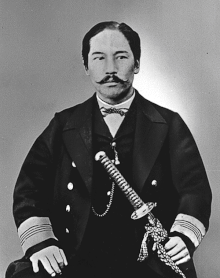Hatamoto
Hatamoto ( Japanese 旗 本 ) were banner people of the Shogun and the daimyo in feudal Japan . As advisers and personal guards for their employer, they formed a group with a special position of trust within the samurai . Well-known Hatamoto were Enomoto Takeaki and Katsu Kaishū , but also the English seaman William Adams .
Similar to the way in which the "upper ten thousand" is often used in modern parlance, in ancient Japan people generally spoke of the "80,000 Hatamoto". A study from 1722 gives their number, however, with only 5,000 people. Together with the lower-ranking Gokenin in the simple civil service, the number was about 17,000.
In the Edo period (1603–1868), Hatamoto was used to describe samurai who swore their loyalty not to a daimyo but directly to the shogun. They were mostly recruited from families who fought on the Tokugawa side in the Battle of Sekigahara . Rank Higher hatamoto (and daimyo), who had the right to a personal one-on-audience with the shogun, had the status of a Omemie -Ijo . The Tokugawa shogunate seems to have distinguished only two classes of followers anyway, with the terms Hatamoto and Omemie-Ijo and Gokenin and Omemie-Ika (i.e. followers without audience rights) being used synonymously .
In contrast to the Daimyō, the Hatamoto had only small estates with an income of between 260 and under 10,000 Koku Reis, mostly near Edo , and no castle of their own. If a Hatamoto held an official post, however, he received an additional, sometimes very substantial salary ( yaku buchi ). Hatamoto with more than 3000 koku in income were called Yoriai ( 寄 合 ).
For Hatamoto there was no obligation to sankin kōtai , as they were under the direct control of the Shogun anyway. The Kōtai-Yoriai ( 交代 寄 合 ) were an exception . They were feared and respected by the other samurai because of their special position of trust, but they also had to set higher standards for their behavior.
With the end of the Edo period ( Bakumatsu ) this title was abolished. Like many other samurai, a large part of the Hatamoto was heavily indebted to moneylenders at the time.
literature
- Maison franco-japonaise de Tokyo (ed.): Dictionnaire historique du Japon . Tome 1. Maisonneuve & Larose, Paris 2002, ISBN 2-7068-1632-5 , pp. 915 f . (French, limited preview in Google Book Search).
- John Henry Wigmore (Ed.): Law and justice in Tokugawa Japan. Materials for the history of Japanese law and justice under the Tokugawa Shogunate 1603-1867. University of Tokyo Press, Tokyo 1967-1981.
